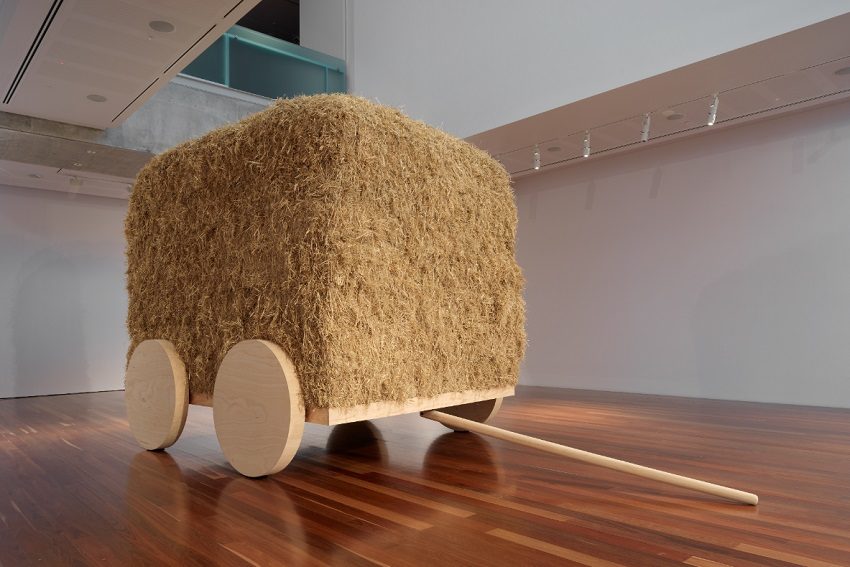Aldo Iacobelli finds the needle in Bosch's haystack

Aldo Iacobelli has been having a long conversation with Hieronymus Bosch. It seems almost inevitable now that Iacobelli should be drawn into the force field of the Netherlandish artist’s imagination.
Bosch lived at the end of the medieval period (around 1500), a time of radical change in the social and political topography of Europe, which infected societies with optimism and also anxiety about the pace of change. He is one of those charismatic figures in the history of art who not only speak for their time but appear, in many senses, to be a contemporary spirit — or a proto-modern as some historian like to describe it.
The best-known of Bosch’s works, particularly his triptychs The Garden of Earthly Delights and The Haywain Triptych, map out the choices on offer to humanity in vividly illustrated depictions of heavenly promise, earthly delights and hellish damnation. His influence on contemporary art and culture extends beyond Surrealist artists like Salvador Dali and the Britpop Chapmans to popular culture such as a Deep Purple’s third album cover and a Bosch-themed Dr. Martens 2014 spring/summer season line in boots, shoes and sandals.
Iacobelli’s engagement with Bosch avoids the conventional riff-offs of fabulous beasties, love-ins and hell-raking. He has paid his dues in front of the originals. Sure there are always the big themes to respond to; the endless battle between good and evil which the contemporary world shares with the medieval. But Iacobelli continues to search for the artist within. He recognises in Bosch’s art a shared belief in the workshop (or studio) process in which ideas are generated and continually put to the test. This explains why Iacobelli stamps his own works with a ‘studio-of’ chop and goes a fair way to explaining why this current exhibition is disposed as an open studio; large works sit side by side with small drawings and sculptural objects that look to have escaped from one of the artist’s sketchbooks (not to mention a roll of canvas (Cloud) perched high on a wall, waiting to be called into service to illustrate another idea).

A small painting (The Mirror) reveals how closely Iacobelli aligns his practice with Bosch. It contains an inscription from one of Bosch’s drawings (The Wood Has Ears, the Field has Eyes): “It is characteristic of the most dismal of minds always to use clichés and never their own inventions”.
As illustration of this principle, Iacobelli quotes from another Bosch work, The Cure of Folly (also known as Cutting the Stone), which depicts a doctor performing an operation on a man’s head, removing the s-called ‘stone of madness’.
The fact that a waterlily, not a stone, has apparently been extracted serves to identify the doctor as a quack and the patient a gullible peasant. But Iacobelli has seized on this image to illustrate how easily one’s perception can be led astray by the power of suggestion. Because he read ‘stone’ he saw one — not the flower staring him in the face over all those years of looking. In response, Iacobelli has fashioned a self-portrait bust, perched Davros-style (from Dr Who) on a wheeled lectern, his sightless eyes unaware of the stone placed alongside.
Iacobelli’s implied avatar has wheels and so too do a number of his creations, homunculi, mutants, disgorged food, snatches and scratches that might be a nest or a cage, smothered in pitch and mounted on miniature wheeled trolleys. They are scattered in the shadows of a full-size hay wain, like minions serving a master. The fearless inventiveness and improvisation of these small structures echoes Bosch’s capacity to create astonishing hybrids from assemblages of everyday objects.
Iacobelli’s hay wagon is intentionally similar in form to the one that dominates the central panel of Bosch’s Haywain triptych. Given the enduring narrative of this triptych’s moral message about doing good and avoiding the seductive pleasures of earthly life it is natural that one looks in Iacobelli’s proposition for some similar injunctions. Much of his practice has referenced this sense of moral principles being compromised by base desires and fears. But his Cart holds its secrets tightly like a pyramid. It’s a mute brute open to any number of interpretations.
Think ‘fodder’ then look at the large wall-mounted work nearby, Triptych in Grisaille with a hanging mechanism. The material used to create these panels, which look so much like erupting mutant cell cultures, is The Advertiser newspaper pulp. The artist confides that when tapped these panels give a hollow sound. Funny that.
A conversation with Jheronimus is a compelling and immersive experience, capricious in its instinctive exploration of the liminal zones between imagination and reality and perhaps good and evil. Meaning is a needle in this particular haystack. Look for the gleam in the artist’s eye.
Aldo Iacobelli: A conversation with Jheronimus
Samstag Museum of Art
Until Friday, August 31
unisa.edu.au/samstagmuseum
Header image: Aldo Iacobelli, The Cart, 2017-18, hay bales, mild steel, wood, 350 x 310 x 625cm. Construction by Tony Rosella and George Street Studios. Commissioned by Samstag Museum of Art, University of South Australia. Photo: Grant Hancock.